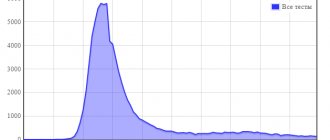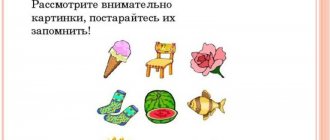You may already have become familiar with one interesting technique for memorizing information to successfully prepare for a session. But we decided not to stop there and introduce you to at least four more effective methods for quickly memorizing text or any other information. Read, think, choose the one that suits you.
All of the following techniques are based on repeated reading. But we are not talking about haphazard and thoughtless reading, but about deep work on the text.
Mastering the text in 4 repetitions: the OVOD method
The name consists of the first letters of the names of the main stages of text memorization:
- Main thought. The text is read for meaningful perception and identification of main ideas, establishing relationships between them. There is no need to perceive everything in the text. If necessary, basic information is underlined or written out on a separate sheet of paper.
- Careful reading. The second reading is characterized by increased attentiveness and thoughtfulness; you should pay attention to small details and details. The text is read slowly. The main task of this stage is to mentally link the details to the main thoughts. At the end of the stage, you need to try to remember the main thoughts and the details already attached to them.
- Review . The text is skimmed quickly, without in-depth reading. Viewing starts from the end. The reader mentally asks himself questions about the main points and tries to draw parallels with the information already received about the text. At this stage, a rough outline of the text is drawn up and the order of the main thoughts is remembered.
- Finishing . Repetition of the text from memory in a certain sequence: they remember the main points, gradually moving on to the details. At this stage, if possible, you should avoid looking into the text. Then there is a re-reading with mental “notches” in those places that the reader missed or forgot. Why did it happen so? If the missing information is significant, it should be worked through.
Among all the methods of assimilation of information, this one is suitable for small texts.
Since new information is quickly forgotten after the initial introduction, it is worth repeating it a little later (a few hours later on the same day or the next). Over time, the dynamics of forgetting slow down.
Massive memorization method
This method is familiar to us from school. It is as simple, understandable and bears fruit as possible.
Take notes on the material you need to learn.
Write out your main points by hand, paraphrase them in clearer language, highlight important information with a contrasting color, use lists and numbering. This will help not only to delve into the material and remember it for a long time, but also, if necessary, to quickly refresh your memory of the main points.
But that’s not all, because we are talking about massive memorization, and, therefore, we use all the senses. Therefore, we not only rewrite and review the material, but also speak and listen to it.
Reading aloud and mental repetition: the OCHOG method
This method of quickly memorizing information is similar to the previous one, but it also has its differences.
An experiment was conducted at Kazan University, during which the subjects formed 4 groups. The task for everyone is to remember the text. In the first group, the text was read aloud 4 times. In the second, the text was read aloud 3 times and mentally retold once by the students. In the third, the text was read twice and retold twice mentally. In the fourth, the text was read aloud only once, and mentally retold 3 times by the listeners.
The results showed the greatest memorization efficiency among students of the fourth group. Students of the third group remembered information a little less effectively, students of the second group remembered the information worse than the others.
Thanks to this experiment, the OCHOG method appeared:
- Orientation . When reading a text, it is important to understand its main idea. If necessary, write it down or underline it, repeating it in memory many times.
- Reading . When reading again, the information is read more carefully, smaller details are highlighted, and a connection is established between them and the main ideas of the text. The main thoughts attached to details are repeated mentally several times.
- Review . A quick review of the text determines whether the main ideas and their connection to the details have been correctly identified. For a deeper understanding, you can ask questions to the main parts.
- Main . A mental retelling is performed, and, if possible, out loud. At this stage, it is important to remember the main thoughts and answer the questions posed.
Try to keep the number of readings to a minimum. In this case, the number of mental repetitions can be absolutely any necessary for better assimilation in memory.
Types and intervals of repetitions
Repetition of information can be divided into several groups:
- Time Dependency: Ultra-short-term
is when it needs to be repeated quickly and reproduced soon. For example, in one hour. Used for memorizing arrays of information at competitions, for training, and practicing memorization skills. - Short-term
is repetition over a distance of several days to a week. The usual period is 3 to 5 days. - Long-term
- if we need information for a long time, then it needs to be repeated at intervals of a week or more. This will allow you to remember it from several weeks to several years.
- Repetition from memory
is when you hold information in your head and use what you have stored in your memory when repeating. It happens:
- By location
- this is when memorizing new information occurs by converting it through associations into visual images and attaching it to old, familiar elements, some cells in our memory
,
which are locations.
is when paper flashcards act as a stimulus for recalling another piece of information. Used, for example, when memorizing foreign words.
, these are also a kind of cards, but the programs are either on phones or on computers. Here information is a kind of hook that will allow you to pull out the necessary information from memory.
is when you read a book and then read it again and repeat it. Any more is useless, since it involves the usual repetition of information.
- Normal repetition
. This is repeated every day several times or every other day. In other words, repeated repetition.
. This is repetition at increasing intervals of time. It could be:
- in manual mode
- this is when you know certain repetition intervals determined personally for yourself;
is when repetition intervals are set for you externally (by some programs or reminder systems).
Which repetition type should you choose?
When choosing the type of repetitions, take into account the timing and volume of information, the goals of memorizing it.
Either we need to know the entire structure of the information being remembered, or high-speed (stimulus) memorization is required. For example, foreign words, countries and capitals, terms. Different goals - different approaches.
On the one hand, you can repeat information every day. However, this approach is not as effective because you spend a lot of time.
The most convenient method in this regard is the method of interval repetitions. And if you combine it with various memorization techniques, it will be a huge breakthrough for learning.
Mnemonics will allow you to immediately work and remember a large amount of information, and interval repetitions will help transfer this volume to long-term memory.
It can be used when you know the intervals for yourself and strive to fall within them. Typically this happens as follows:
- immediately after memorization;
- further, during the day;
- then the next day;
- then within 3 days;
- within 5-7 days;
- 10-14 days;
- 3-4 weeks;
- 2-3 months;
- every 6-12 months.
In this case, each interval is counted from the previous step. Using such a system, you can study any knowledge available to you much faster.
Let us tell you how this works using the example of the most popular training systems.
Methods for memorizing large amounts of information: Cicero’s method
The previous methods are suitable for working with small texts. But what to do if you need to quickly master and remember entire notes, books, works?
As you might have guessed, this technique was named after Marcus Tullius Cicero, a brilliant orator and great statesman of Rome who lived in 106-43. BC.
It was not only his smartest thoughts that brought fame to this man. In his speeches, he never used notes, reproducing from memory a huge number of dates, facts, quotes of historical events and names.
This is one of the best methods for remembering information due to its simplicity. It is also called the room system or the seat method .
The idea is to mentally arrange the important facts in a certain order in a familiar room. Then, if necessary, you will just need to remember that very room to fish out the necessary information. It was this technique that Cicero himself was guided by when preparing for speeches: he mentally walked around his house, placing the main points of the speech in it as conveniently as possible for himself.
Before you start mastering the method, it is important to choose your own sequence of walking around the rooms, so as not to get confused in your own logic of placing information.
For your first acquaintance with memorizing information in this way, try to actually walk around your home, mentally arranging information in its place. Then it won’t be necessary to walk around the house; it’s enough to mentally repeat the route you’ve taken.
Here are some tips that will help you arrange the information correctly:
- The best place to start is in your own room. Take the door as a starting point, then follow the left-hand rule (examine everything on the left side in order) and slowly move further clockwise;
- when placing information sequentially, it is worth taking into account stationary objects that always stand in the same places (curtains, chandelier, floor lamp, sofa, picture, photo frame, cornice, shelves, etc.);
- You should use sequential movement not only from left to right, but also from top to bottom, since objects are often located one under the other (a carpet under a sofa, a table under a chandelier, etc.);
- If you need to remember multi-level lists, use not only your home, but also the homes of your relatives, friends, the lecture hall, and even well-studied routes from home to school, to the store, etc.
Over time, as you become more familiar with this method, you will be able to use increasingly smaller objects from rooms and find increasingly secluded places to store information in your memory. But at the very beginning it is better to limit yourself to the most noticeable objects in the room.
This method has proven itself well when working with large texts, daily routines, and remembering the order of phone calls. Moreover, if important information is somehow connected with each other, and is not just a meaningless set of data, then you can reuse the same room several times.
The Cicero method is great for memorizing numbers. True, you will first have to convert the numbers from an abstract form to a more concrete one in any convenient way. And only then you can use the objects into which the numbers were converted to fill the spaces in the room.
The huge advantage of this method is that 2-3 training sessions are enough to master it, unlike many other techniques. In addition, it can be used in absolutely any situation and anywhere. At the same time, the very place where you are at a particular moment (auditorium, dacha, museum, dean’s office) will serve as support and help for you. All you need is to remember in detail a familiar room or use the one you are in at the moment.
We invite you to practice and try to reproduce the words below from memory using Cicero’s method: float, napkin, curlers, grass, mirror, album, comb, book, cat, light bulb, matches, blanket, scissors, ladle . You can use the picture as a sample room:
Cicero's method can also be used to solve inverse problems: use a well-known series of words to remember the furnishings of a room
This technique is one of the most effective methods for promoting effective memorization of text information.
Memory technique No. 2. Writing a story or story
This method is easy to use and does not require special skills. Its essence boils down to compiling a story in which the characters will be visual images associated with memorized information.
For example, you need to remember the same shopping list - milk, cheese, loaf, apples, soap. To do this, we are writing a story in which the main characters will be products from our list.
Example: Imagine... You open the door to a store and... here, you are picked up by a wave of a milk river that flows out of the open doors. You miraculously manage to grab onto a piece of cheese floating by. Holding on to the saving cheese, you swim to an unusual island on which, instead of leaves on the trees, loaves grow. You feel hungry, pick up a stone from the ground to try to knock down a loaf, and then the stone turns into a juicy red apple. Are you surprised. Bring the apple to your mouth and want to taste it. You bite and realize that you have a bar of soap in your mouth. Wince. You throw it aside.
This is the story we have. A little crazy, but it gets the job done. We remembered the shopping list.
This method has a peculiarity - the more unusual the story, the better you will remember it. Now about the advantages and disadvantages of this method.
Pros: - easy to use; — does not require special training; - quite versatile. Disadvantages: - large time costs; — limitation in the amount of data to be remembered (for example, a list of 20 or 30 elements will be difficult to remember).
Using visual memory: the pictogram method
A pictogram is a set of graphic images that a person comes up with himself for the purpose of memorizing and subsequently reproducing any words and expressions.
The pictogram method in psychology is often used to study, diagnose and strengthen memory in people with a “visual” image (visuals).
During the study of thinking using the pictogram method, the following plan was developed for working with text information:
- The text highlights key words or short phrases that should be written down and underlined.
- For each word or phrase, a pictogram is drawn - a kind of image that will later help you remember that particular word/phrase. The image here plays the role of visual association. When drawing, you should not use sketchiness or unnecessary details. The picture should not contain numbers or letters. The process of creating an image should not take more than 10-20 seconds. Example: to remember the phrase “hard work,” you can draw a hammer or a person bent under a heavy load. The phrase “merry holiday” can be associated with fireworks, flags, a Christmas tree, etc.
Pictograms surround us everywhere: in stores, at airports, in vehicles, on the road.
A pictogram cannot be right or wrong. This is an association that belongs specifically to you and was created to fulfill the main goal - to remind you of the word or phrase to which it was attached.
It is much easier to make a drawing for a specific object (ice cream, bear, nose) than for a process or abstract concept (development, longing, reflection). But even in this case, the issue can be easily resolved - you just need to assign them a more substantive association, transform them into something specific. For example, for the word “development” you can use the image of a spiral, for the word “melancholy” - a tear or an anti-smile, for “reflection” - a light bulb, etc.
By the way, the game “Crocodile” is also based on the pictogram method. A person tries to show the concept given to him using his own associations
There are also words of average complexity of specification, for example, a school can be depicted with a desk, a blackboard, a hospital with a bed or a red cross, etc.
Several examples of the Kherson pictogram method
Before you start using the pictogram method, you need to practice. This will allow you to get better at drawing and prepare for the immediate task.
Sample exercise : Draw pictograms for the words below. Please note that words of different complexity are used here. Try to draw a picture so that after a few hours you can remember the word for which you created the picture.
After a few hours, try to reproduce all the words in accordance with their pictogram, and then reproduce the entire text, looking at your pictures. Using the pictogram method when preparing for exams, you can use a sheet of paper with pictures as a cheat sheet, which you won’t be afraid to put on your desk in real time. exam.
By the way! Our readers now have a 10% discount on any type of work.
Using an accumulation system: Atkinson's method
But Atkinson is confident that memory should improve gradually, without sudden jumps and overloads. Therefore, the only safe and proven method of strengthening memory is the accumulation method.
The scientist proposes to leave aside all artificial techniques, using only what nature itself has given us. The brain, like all muscles, needs training and gradual loads. As loads increase, memory efficiency will also increase.
This system was actively used in ancient times, when only a select few knew how to use a pen, and wise men could not always trust their secrets
The essence of the system is this:
- Choose a text (optimally in poetic form). On the first day, 4 to 6 lines are learned by heart.
- On the second day, they repeat yesterday’s learned lines and additionally learn 4 to 6 more lines.
- On the third day, 4-6 new lines are added to those already learned.
The greater the number of repetitions, the better the new material is remembered.
It's okay if you peek at the book from time to time. Don’t be upset if you forget something: over time, your memory will increase and memorization will become easier.
After a month, double the amount of information you master. In another month, you can triple the amount of information.
Research has shown that as a result of using this technique:
- learned knowledge remains for a long time and easily emerges in memory,
- the ability to remember absolutely any thing improves all the time,
- With the help of willpower, any information is easily remembered.
The essence of this method is nothing other than repetition. It is better to conduct classes in the morning, since at this time of day our perception is still fresh. Train every day and you will see: within a month your brain will begin to remember many times more information.
How the brain remembers information
Our main computer in the body has a unique memory, and the process of memorization itself is unique. Now let’s dive a little into the terminology of physiologists and psychologists, bear with us for a moment.
So, scientists know that the process of memorization requires a large amount of body energy. This is brain metabolism in simple words. Energy is expended as many nerve cells (neurons and glia) constantly create new connections (chains). Biologically based memory is the ability of the nervous system to retain the activity of previously excited neurons.
They are excited by some bright event or a deliberate desire to retain information. With each subsequent repetition, these connections will become more active, which allows you to remember the information longer. Therefore, repetition is always effective when you want to reproduce something over time. This principle underlies the improvement of memory and brain function.
But there are special methods that help you remember a large amount of information in a short time. We will look at them below.
What's important to remember?
Multiple unsystematic repetition of information is unproductive.
And your memory can and even should be trained! Memorizing something new is useful not only when preparing for exams, but also for life in general. Soon after starting to use the chosen technique, you can see how the brain begins to remember other information that we use in life: remembering telephone numbers, addresses, regulating incoming/outgoing correspondence and much more.
The secret is that after repeated training, the memory automatically begins to apply the skill of remembering more information. And this is without the use of any mnemonic techniques or training. However, it is still worth helping your brain from time to time by sorting important and unimportant information. For example, when preparing for an exam in a discipline that will not be useful to you in real life, there is no point in learning a lot of useless information. It is enough to ask for help from people who will do it for you.
And here you can watch a video on methods of memorizing OVOD and OCOG - the most popular way to increase memory:
What is memory
In our time, when it is possible to record, find and retrieve information from any medium, good memory is still valued and the question: “how to quickly remember information” remains relevant.
Sometimes memorizing seems like a pointless exercise, because you can go online and “remember” what you need. However, there is not always time to search for information; sometimes you urgently need to remember or remember.
In addition, memory, which is not used, gradually loses its functions, and along with this, other mental cognitive processes suffer, and the IQ drops.
Memory needs to be trained! This is not difficult to do - you need to use it more often, facilitating the processes of memorizing, storing and reproducing information using various methods and techniques.
Memory is a complex mental cognitive process, function and ability, which includes four stages: memorization, storage, reproduction and forgetting.
Thanks to the presence of memory, a person learns and develops as a person, since he has the opportunity to store accumulated life experience, knowledge, skills and abilities.
The older a person is, the more often the question arises: “How to remember a large amount of information?” Although almost all people face the problem of memorization. Normally, if from birth to twenty-five years of age memory only improves, in adulthood it remains relatively constant, and in old age it worsens.
Many techniques have been developed to facilitate the memorization process. Those that improve memory through the formation of associative connections are called mnemonics.
A set of mnemonics is called mnemonics, translated from ancient Greek as “the art of memorization.” This is the most popular method of memorizing information for a long time today.











